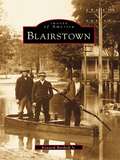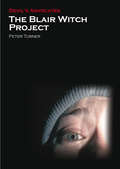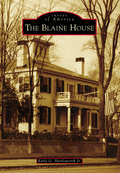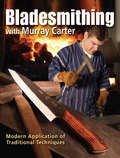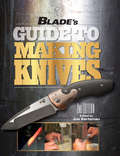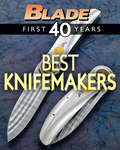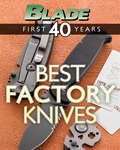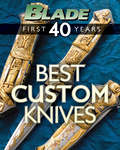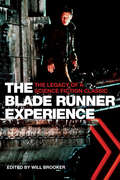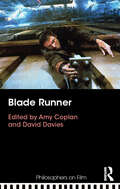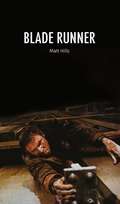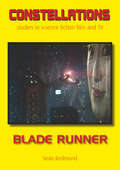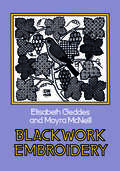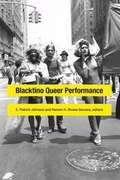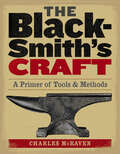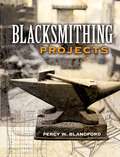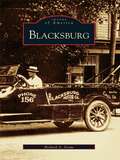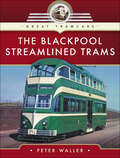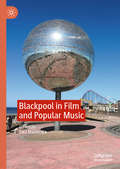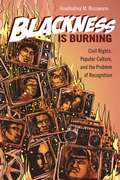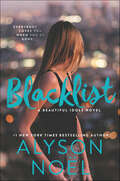- Table View
- List View
Blairstown
by Kenneth Bertholf Jr.Blairstown, New Jersey lies along the summit of the Blue Mountains, and from that point down to the Valley of the Paulinskill is a succession of hills and valleys. Tammany, Chief of the Delaware, calledthis area "Touockonetcoug," which means "Gem of the Paulinskill." The beautiful forests, streams, and mountains of this area make it the perfect subject for an engaging pictorial history. Images in this book include those of the first families to settle in the area, including the Blairs and the Howells. The town was named for the Honorable John I. Blair, one of its earliest prominent citizens, and was formed from a part of Knowlton Township by an act of the State Legislature in February 1845. In this collection discover Blairstown as it once was, prior to the many changes that were made in the name of progress. View original homesteads, businesses, and schools in the community, and learn about the residents who shaped its future. Photographs and postcards depicting the construction and completionof railroad lines are shown, along with images of recreational retreats such as Silver Lake and Cedar Lake. Photographs of surrounding communities, including Delaware, Columbia, Hainesburg, Vail, Hope,Johnsonburg, and Centerville are also included in this collection.
The Blair Witch Project
by Peter TurnerTells the story of the film from conception and production to audience response.
The Blair Witch Project
by Peter TurnerFew films have had the influence and impact of The Blair Witch Project (1999). Its arrival was a horror cinema palette cleanser after a decade of serial killers and postmodern intertextuality, a bare bones 'found footage' trend setter. In this Devil's Advocate, Peter Turner tells the story of the film from his conception and production then provides a unique analysis of the techniques used, their appeal to audiences and the themes that helped make the film such an international hit, including the pionerring internet marketing.
Blaine House, The (Images of America)
by Earle G. Shettleworth Jr.The Blaine House in Augusta is one of Maine's most notable homes. In 1862, three decades after the house was built by Capt. James Hall in the early 1830s, James and Harriet Blaine moved in. The home became the setting for one of the most meteoric careers in American politics, during which James Blaine served as Speaker of the US House of Representatives, US senator, secretary of state, and Republican candidate for president in 1884. After the deaths of her parents, the Blaines' daughter Harriet Blaine Beale gave the house to the state in 1919. Since 1920, it has served as the official residence of the state's governors and their families. As a symbol of state government, it ranks with the Maine State House. The house has been a National Historic Landmark since 1964. Architecturally, it reflects a combination of Federal, Victorian, and Colonial Revival styles. Today, the Blaine House functions as a social showcase for Maine, a working office, and family living quarters.
Bladesmithing with Murray Carter: Modern Application of Traditional Techniques
by Murray CarterBladesmithing with Murray Carter provides the reader with an in-depth look into traditional Japanese Cutlery forging techniques and their modern applications. A non-stop flow of inquiries to Murray has prompted him to reveal the secret techniques learned during 18 years in Japan, where he lived and worked as a village bladesmith. He now shares this wealth of information for the benefit of the curious reader and Japanese knife enthusiast alike. Owners of nearly 15,000 of Murray's knives will be delighted to see a comprehensive book written by the knives' creator. Features: 250+ dazzling, full-color images, including many by renowned photographer Hiro Soga. Unique and extremely rare insight into the Japanese culture through the (blue) eyes of a Japanese village bladesmith. Detailed explanations of Traditional Japanese Bladesmithing techniques that until now have been cloaked in mystery and myth. Enough detailed information to guide an aspiring bladesmith to become a successful smith in the Japanese style of blade making. About the Author Murray Carter is one of the most popular custom knifemakers at the annual BLADE Show, regularly conducts wildly popular seminars on shaving with a machete, and is known for standing at his booth sharpening knives while teaching the techniques to interested attendees. Carter lives in Vernonia, Oregon.
BLADE's Guide to Making Knives
by Joe KertzmanLearn the Secrets of Knifemaking From the Masters of the Trade With an all-star cast of renowned knifemakers, BLADE's Guide To Making Knives 2nd Edition brings you the most up-to-date, inside information available on fashioning edged implements. In this full-color, meticulously illustrated volume: John Lewis Jensen, designer and fabricator of one-of-a-kind ornamental edged weaponry, presents a step-by-step guide to creating your own art knife in "Desk Daggers: A Limited Edition Jensen Knives Trio." Tim Zowada, forger of damascus and smelted steel, reveals his trade secrets and methods in "Making the Using Knife." Allen Elishewitz lends his knowledge and know-how in "Making Patterns and Using a Pantograph," for those in the design stages of fashioning fine knives. Don Fogg, arguably one of the best sword makers on the planet, shares his expertise in "Forging Steel from Raw Materials." Vince Evans, crafter of Scottish dirks, Viking swords, Central Asian weaponry and other exotic and historical pieces, reveals his methods for "Making and Carving a Scottish Dirk." Rick Dunkerley, known for his mosaic-damascus masterpieces, opens his world of knowledge in "Building a Damascus Locking-Liner Folder." Kevin Hoffman unlocks the mysteries of "Lost Wax Casting for Guards & Pommels," illustrating each and every step of this tedious yet rewarding process. It's All Here! Forging - Grinding - Heat Treating - Etching - Polishing - Sharpening Blades - Guards - Pommels - Bolsters - Handles - Sheaths Whether your interest in making knives is new or you've been crafting blades for years, BLADE's Guide to Making Knives 2nd Edition arms you with knowledge to help you reap the rewards of a fruitful and fulfilling knifemaking hobby or career.
BLADE's Best Knifemakers
by Blade EditorsBLADE enters the home stretch in observance of its 40th anniversary by doing a three-part series recognizing the top 40 custom knifemakers over those first 40 years (1973-2013).We compiled a list of some of the top makers and submitted it to a panel of seasoned knife observers and asked them to select their top five to 10 and rank them.Though "top custom knifemakers" can be subjective, we would like to think a top maker is one who excelled in terms of setting a standard that other makers attempted to emulate, and/or excelled in quality of craftmanship, originality, and creativity - or both.
BLADE's Best Factory Knives
by Blade EditorsThey may have been your father's knives or your grandfather's knives - they may even be your knives. To help celebrate its 40th anniversary, BLADE released a three-part series recognizing the top 40 factory knives over that span (1973-2013). The first chapter pinpoints the top factory knives from 1973-1988. The second chapter includes 1989-2000, and the third chapter covers 2001-2012.
BLADE's Best Custom Knives
by Blade EditorsThis collection of articles marks the 40th anniversary of BLADE. Part one covers the years 1973-1988; part two, 1989-2000; and part three, 2001-2012.
The Blade Runner Experience: The Legacy of a Science Fiction Classic
by Will BrookerSince its release in 1982, Ridley Scott's Blade Runner, based on Philip K. Dick's novel Do Androids Dream of Electric Sheep?, has remained a cult classic through its depiction of a futuristic Los Angeles; its complex, enigmatic plot; and its underlying questions about the nature of human identity. The Blade Runner Experience: The Legacy of a Science Fiction Classic examines the film in a broad context, examining its relationship to the original novel, the PC game, the series of sequels, and the many films influenced by its style and themes. It investigates Blade Runner online fandom and asks how the film's future city compares to the present-day Los Angeles, and it revisits the film to pose surprising new questions about its characters and their world.
The Blade Runner Experience: The Legacy of a Science Fiction Classic
by Will BrookerSince its release in 1982, Ridley Scott's Blade Runner, based on Philip K. Dick's novel Do Androids Dream of Electric Sheep?, has remained a cult classic through its depiction of a futuristic Los Angeles; its complex, enigmatic plot; and its underlying questions about the nature of human identity. The Blade Runner Experience: The Legacy of a Science Fiction Classic examines the film in a broad context, examining its relationship to the original novel, the PC game, the series of sequels, and the many films influenced by its style and themes. It investigates Blade Runner online fandom and asks how the film's future city compares to the present-day Los Angeles, and it revisits the film to pose surprising new questions about its characters and their world.
Blade Runner (Philosophers on Film)
by David Davies Amy CoplanRidley Scott’s Blade Runner is widely regarded as a "masterpiece of modern cinema" and is regularly ranked as one of the great films of all time. Set in a dystopian future where the line between human beings and ‘replicants’ is blurred, the film raises a host of philosophical questions about what it is to be human, the possibility of moral agency and freedom in ‘created’ life forms, and the capacity of cinema to make a genuine contribution to our engagement with these kinds of questions. This volume of specially commissioned chapters systematically explores and addresses these issues from a philosophical point of view. Beginning with a helpful introduction, the seven chapters examine the following questions: How is the theme of death explored in Blade Runner and with what implications for our understanding of the human condition? What can we learn about the relationship between emotion and reason from the depiction of the ‘replicants’ in Blade Runner? How are memory, empathy, and moral agency related in Blade Runner? How does the style and ‘mood’ of Blade Runner bear upon its thematic and philosophical significance? Is Blade Runner a meditation on the nature of film itself? Including a brief biography of the director and a detailed list of references to other writings on the film, Blade Runner is essential reading for students – indeed anyone - interested in philosophy and film studies. Contributors: Colin Allen, Peter Atterton, Amy Coplan, David Davies, Berys Gaut, Stephen Mulhall, C. D. C. Reeve.
Blade Runner (Cultographies)
by Matt HillsMore than just a box office flop that resurrected itself in the midnight movie circuit, Blade Runner (1982) achieved extraordinary cult status through video, laserdisc, and a five-disc DVD collector's set. Blade Runner has become a network of variant texts and fan speculations-a franchise created around just one film. Some have dubbed the movie "classroom cult" for its participation in academic debates, while others have termed it "meta-cult," in line with the work of Umberto Eco. The film has also been called "design cult," thanks to Ridley Scott's brilliant creation of a Los Angeles in 2019, the graphics and props of which have been recreated by devoted fans. Blade Runner tests the limits of this authenticity and artificiality, challenging the reader to differentiate between classic and flop, margin and mainstream, true cult and its replicants.
Blade Runner
by Matt HillsMore than just a box office flop that resurrected itself in the midnight movie circuit, Blade Runner (1982) achieved extraordinary cult status through video, laserdisc, and a five-disc DVD collector's set. Blade Runner has become a network of variant texts and fan speculations--a franchise created around just one film. Some have dubbed the movie "classroom cult" for its participation in academic debates, while others have termed it "meta-cult," in line with the work of Umberto Eco. The film has also been called "design cult," thanks to Ridley Scott's brilliant creation of a Los Angeles in 2019, the graphics and props of which have been recreated by devoted fans. Blade Runner tests the limits of this authenticity and artificiality, challenging the reader to differentiate between classic and flop, margin and mainstream, true cult and its replicants.
Blade Runner
by Sean RedmondRidley Scott's 1982 film Blade Runner is now widely recognized as an undisputed masterwork of science fiction cinema and one of the most influential films released in the last forty years. Yet on its original release it was both a critical and commercial failure, criticized for its perceived prioritizing of style over content and a narrative that did not deliver the anticipated high octane action that its star casting and large budget normally promise. How did a film that was removed from circulation within a month of its premiere come to mean so much to modern audiences and provide such a rich seam of material for film and media studies? Sean Redmond excavates the many significances of the film - its breakthrough use of special effects as a narrative tool; its revolutionary representation of the future city; its treatment of racial and sexual politics; and its unique status as a text whose meaning was fundamentally altered in its re-released Director's Cut form, then further revised in a Final Cut in 2007, and what this means in an institutional context.This volume was previously published as Studying Blade Runner in 2008.
Blade Runner: Instructor's Edition (Constellations)
by Sean RedmondRidley Scott's 1982 film Blade Runner is now widely recognized as an undisputed masterwork of science fiction cinema and one of the most influential films released in the last forty years. Yet on its original release it was both a critical and commercial failure, criticized for its perceived prioritizing of style over content and a narrative that did not deliver the anticipated high octane action that its star casting and large budget normally promise. How did a film that was removed from circulation within a month of its premiere come to mean so much to modern audiences and provide such a rich seam of material for film and media studies? Sean Redmond excavates the many significances of the film – its breakthrough use of special effects as a narrative tool; its revolutionary representation of the future city; its treatment of racial and sexual politics; and its unique status as a text whose meaning was fundamentally altered in its re-released Director's Cut form, then further revised in a Final Cut in 2007, and what this means in an institutional context.This volume was previously published as Studying Blade Runner in 2008.
Blackwork Embroidery
by Elizabeth Geddes Moyra McneillBlackwork embroidery was very popular in Tudor times, and it is now enjoying a tremendous revival. A form of counted-thread work, blackwork emphasizes shading contrasts that are possible working with a single color of thread. This book is one of the best modern works on blackwork. After covering the intriguing history of blackwork in a lively text and beautiful selection of illustrations, the authors present every aspect of the modern techniques and uses of the craft.There is a discussion of contemporary techniques of transferring a design, stitches, needles, and more; information on how to make a design, including numerous illustrations of examples such as birds, animals, fruit, architectural forms, an angel, a crusader, and more; over 200 illustrations of embroidery patterns, including simple, filling, and border patterns; and coverage of materials and threads with full charts. A new Publisher's Note gives a listing of current American suppliers.Done in black silk on white linen, blackwork was originally used to decorate clothes and household articles. Today, you can still produce effective decorations in black-and-white, but many projects will look even better done in color. You can use blackwork on towels, tablecloths, sheets, and clothes, and you can make very attractive blackwork designs for wall hangings and pillows.
Blacktino Queer Performance
by E. Patrick Johnson Ramón H. Rivera-ServeraStaging an important new conversation between performers and critics, Blacktino Queer Performance approaches the interrelations of blackness and Latinidad through a stimulating mix of theory and art. The collection contains nine performance scripts by established and emerging black and Latina/o queer playwrights and performance artists, each accompanied by an interview and critical essay conducted or written by leading scholars of black, Latina/o, and queer expressive practices. As the volume's framing device, "blacktino" grounds the specificities of black and brown social and political relations while allowing the contributors to maintain the goals of queer-of-color critique. Whether interrogating constructions of Latino masculinity, theorizing the black queer male experience, or examining black lesbian relationships, the contributors present blacktino queer performance as an artistic, critical, political, and collaborative practice. These scripts, interviews, and essays not only accentuate the value of blacktino as a reading device; they radiate the possibilities for thinking through the concepts of blacktino, queer, and performance across several disciplines. Blacktino Queer Performance reveals the inevitable flirtations, frictions, and seductions that mark the contours of any ethnoracial love affair. Contributors. Jossiana Arroyo-Martinez, Marlon M. Bailey, Pamela Booker, Sharon Bridgforth, Jennifer Devere Brody, Bernadette Marie Calafell, Javier Cardona, E. Patrick Johnson, Omi Osun Joni L. Jones, John Keene, Lawrence La Fountain-Stokes, D. Soyini Madison, Jeffrey McCune, Andreea Micu, Charles I. Nero, Tavia Nyong'o, Paul Outlaw, Coya Paz, Sandra L. Richards, Charles Rice-González, Matt Richardson, Ramón H. Rivera-Servera, Celiany Rivera-Velázquez, Tamara Roberts, Lisa B. Thompson, Beliza Torres Narváez, Patricia Ybarra, Vershawn Ashanti Young
The Blacksmith's Craft: A Primer of Tools & Methods
by Charles McRavenGet that metal hot and start hammering! Setting up your own forge and crafting everyday items is easier than you might think. With simple methods, easy-to-follow photographs, and insightful tips, you’ll soon be creating items of lasting beauty and durability from iron and steel.
Blacksmithing Projects
by Percy W. BlandfordIs blacksmithing a lost art? Not according to this master craftsman. It might be one of the world's most ancient crafts, but it remains an exciting and essential one today. Percy W. Blandford presents twenty-four different projects: some are for novices, requiring only a few tools, improvised equipment, and a single propane torch; others call for the skill and equipment of an experienced smith. Projects include:Punches and chisels Traditional candlestickDoor latches and boltsGarden toolsWeather vanesFences and railingsTablesWheelbarrow... and many more! A book of ideas and suggestions, rather than an instruction manual on blacksmithing techniques, this volume features eighty detailed figures and diagrams. It also includes lists of materials, step-by-step instructions, and suggestions for variations in design.
Blacksburg (Images of America)
by Richard A. StrawIn 1798 William Black set aside 38 acres of land in an area known as Draper's Meadow to establish the village that would take his name: Blacksburg, Virginia. In the more than 200 years since its founding, this once small frontier outpost has grown into what the Washington Post recently called "the most wired city in America." A diverse and well-educated community, Blacksburg holds a special place in the hearts of its residents as well as Virginia Tech students and alumni. From its humble beginnings in the late 18th century Blacksburg has evolved into a vibrant, diverse, and progressive community of nearly 40,000. Today Blacksburg sits on the cutting edge of great historical, environmental, cultural, and scientific frontiers, just as it did over 200 years ago.Photos in the book reveal the architectural and physical evolution of a vibrant Main Street, which was and still is the very heart of the town. After 1872 town life began to interact with that of the new state university placed in Blacksburg; this study includes many engaging images of life at Virginia Tech over the years. Fascinating photos of people, places, homes, businesses, and important events in the town's history complete the collection. In this contribution to the Images of America series Straw has provided us with an informative look into an earlier period of life in this most interesting and appealing community.
The Blackpool Streamlined Trams (Great Tramcars Ser.)
by Peter Waller“What a variety are pictured here! Double deck ‘balloon’ cars, single deckers including open topped cars and various illuminated cars, a specialty of the town.” —York Model Engineers newsletterIn the early 1930s the tramcar in Blackpool was at a crossroads; the system needed investment in both new track and new trams while there was a serious threat that the “town” routes might be converted to bus operation.The appointment of Walter Luff as the new general manager was, however, to prove a turning point. Working closely with English Electric, based in nearby Preston, Luff developed a series of streamlined trams—both single-deck and double-deck—that were to revolutionize the town’s tramway. By the end of 1930s, the corporation had acquired more than 100 new trams—the majority built by English Electric but with twenty coming from Brush—that ensured the survival not only of the key route along the Promenade to Fleetwood but also of the bulk of the “town” routes.Over the next seventy years these trams were to form the cornerstone of the Blackpool system. It was only with the modernization of the system in the first decade of the 20th century that, finally, they became largely obsolete but still, as part of the heritage fleet, they remain very much part of the contemporary Blackpool scene.This book examines the history of Blackpool’s streamlined trams of the 1930s from development through to preservation.“An important addition to the more straightforward business and picture book histories of the Blackpool tram network which local historians and industrial archaeologists will find of great value aiding future studies of this subject.” —Transactions of the Lancashire and Cheshire Antiquarian Society
Blackpool in Film and Popular Music
by Ewa MazierskaThis collection examines Blackpool, Britain’s first and largest working-class seaside resort as a location for the production and consumption of British film and popular music, and the meaning of ‘Blackpool’ in films and songs. It examines representation of Blackpool in films such as Hindle Wakes, A Taste of Honey, Bhaji on the Beach, Away, Bob’s Weekend, The Harry Hill Movie and Miss Peregrine's Home for Peculiar Children, linking it to the concepts of heterotopia, purgatory, fantasy, simulacra and the carnivalesque. It also presents music in Blackpool through the history of its venues and examines development of punk and grime music in this seaside town. The authors argue that Blackpool in filmic and musical texts often stands for British culture, but increasingly for culture which is remembered or imagined rather than present and real.
Blackness Is Burning: Civil Rights, Popular Culture, and the Problem of Recognition (Contemporary Approaches to Film and Media Series)
by Treaandrea M. RusswormBlackness Is Burning is one of the first books to examine the ways race and psychological rhetoric collided in the public and popular culture of the civil rights era. In analyzing a range of media forms, including Sidney Poitier’s popular films, black mother and daughter family melodramas, Bill Cosby’s comedy routine and cartoon Fat Albert, pulpy black pimp narratives, and several aspects of post–civil rights black/American culture, TreaAndrea M. Russworm identifies and problematizes the many ways in which psychoanalytic culture has functioned as a governing racial ideology that is built around a flawed understanding of trying to “recognize” the racial other as human. The main argument of Blackness Is Burning is that humanizing, or trying to represent in narrative and popular culture that #BlackLivesMatter, has long been barely attainable and impossible to sustain cultural agenda. But Blackness Is Burning makes two additional interdisciplinary interventions: the book makes a historical and temporal intervention because Russworm is committed to showing the relationship between civil rights discourses on theories of recognition and how we continue to represent and talk about race today. The book also makes a formal intervention since the chapter-length case studies take seemingly banal popular forms seriously. She argues that the popular forms and disreputable works are integral parts of our shared cultural knowledge. Blackness Is Burning’s interdisciplinary reach is what makes it a vital component to nearly any scholar’s library, particularly those with an interest in African American popular culture, film and media studies, or psychoanalytic theory.
Blacklist (Beautiful Idols #2)
by Alyson NoelFans of Pretty Little Liars will crave the mystery and suspense in the second book of #1 New York Times bestselling author Alyson Noël’s Beautiful Idols series, where celebrity worship is a dangerous game.Wannabe reporter LAYLA, aspiring actress ASTER, and fledgling musician TOMMY joined the Unrivaled nightclub competition for the same reason—they knew winning it would change their lives. They just never imagined that somewhere along the way they’d become entangled in the disappearance of mega starlet MADISON BROOKS. Now each of them is smack in the center of a media frenzy that threatens to take all of them down.Banding together to clear their names, the fierce adversaries become temporary allies and vow to dig up the truth. But when Layla, Aster, and Tommy team up with an unsuspecting insider, they will find that some secrets are best kept in the grave.
